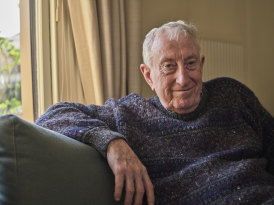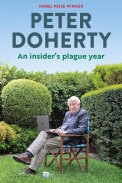The Attenborough of the pandemic Peter Dohertys new book makes sense of it all
Review: An Insider’s Plague Year, Peter Doherty, Melbourne University Press, $32.99
Australian Nobel laureate and viral immunologist Professor Peter Doherty is the David Attenborough of the COVID-19 pandemic. His knowledgeable, humble, passionate, honest and frequently humorous commentary in the media, on social media and online has been the narrative so many needed to make sense of a world in utter turmoil.
To read Doherty’s latest book, An Insider’s Plague Year, is to absorb that narrative in condensed form. It bundles together the many articles that Doherty has typed from his Melbourne home since SARS-CoV-2 first reared its spiky head in late December 2019, organised into a roughly linear thread that finishes in February 2021 when the book went to print.

Peter Doherty is a hero to many as a person who strives constantly to use his intellect and platform to make the world a better place.Credit:Ben King
It’s an odd feeling as a reader because we are reading his questioning, prophesying words from a future that Doherty speculates about â€" pretty accurately too â€" but that at the time had not yet come to pass.
What makes this a fascinating read is that Doherty is not just an eminent scientist whose career-defining achievement was to discover how a type of immune cell called a T cell eliminates virus-infected cells (for which he won a Nobel Prize); he’s also a great communicator, prolific writer, and has a genuine and infectious love of all knowledge.

Credit:
Doherty had a unique vantage point during the pandemic. At the end of 2019, he had planned to fade quietly away from the scientific frontline, which he says is the best thing an “eminent old scientist†can do. Then COVID-19 happened. But instead of inserting himself back into the laboratory, Doherty felt he had more to offer as a science communicator, to help take the pressure off the working scientists at the Doherty Institute. So he started a new career as a “junior journalistâ€, participating in regular meetings with the institute’s frontline scientists and working with the communications and media team.
The book ranges widely across history (of science, of course), science (immunology and vaccinology in particular), society, politics and even climate change, as Doherty explores not just the science of the pandemic, but the context in which it is taking place and the future it will shape.
The book is organised into three sections. The first short section looks at the start of the pandemic, from late 2019 to March 2020, and how the groundwork was laid for the Doherty Institute to become the leading scientific reference point for government policy â€" a role it still plays, as evidenced by the recent modelling report that has informed the government’s latest roadmap to a post-COVID Australia.
The second section, which makes up most of the book, is a collection of weekly columns he wrote â€" and continues to write (he’s up to his 69th column) â€" for the Doherty Institute website, under the title Setting it Straight. These columns are the narrative of the COVID-19 pandemic: Doherty applying his in-depth understanding of infection and immunology to a problem that is evolving in front of him.
Some columns are much more technical than others. Even as someone who has reported in-depth on this pandemic since the early days, there are some deep dives into immunology that require the intellectual equivalent of a deep-sea submersible. Thankfully, Doherty has a knack for quirky metaphors, which he frequently employs to help walk the reader through the baffling complexity of the immune system and its interactions with the SARS-CoV-2 virus.
These columns could be described as “everything you ever wanted to know about immunology but were too afraid to askâ€. They have the detail of a textbook, but are far more engaging and relevant in how they tie back to the virus that has dominated our world for more than 18 months. There are also excellent chapters on vaccine development and on how drug-regulatory systems work, which could hopefully allay some concerns about the speed of development and deployment of these life-saving innovations during the pandemic.
The final section of the book is a short collection of essays and articles written about the future, the importance of science writing and science communication, and a biography of the Doherty Institute during the pandemic that feels like an attempt to name and give credit to the many staff members who have worked tirelessly through the pandemic.
Doherty is a hero to many, not just as a scientist but as a person who strives constantly to use his intellect and platform to make the world a better place. So, who are his heroes in this world-changing event?
The dedication reveals who he holds in the highest esteem: “the frontline healthcare professionals across the planet who have given their all through this pandemic″â£.
The Booklist is a weekly newsletter for book lovers from books editor Jason Steger. Get it delivered every Friday.

0 Response to "The Attenborough of the pandemic Peter Dohertys new book makes sense of it all"
Post a Comment